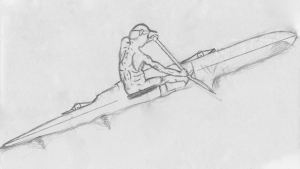
Tahiti bound . . .
At 6:30 a.m. my mom, Trent and I left Kandu and motored the dinghy to shore so that Trent and I could catch the bus to school. We entered the school gates at 7:00 a.m. I was ready and on time. The team paddlers showed up one by one until it was time to load into the airport bus and head to the airport, an hour and a half away. The team coaches rounded up all the paddles and life jackets and loaded them into the bus separately as the paddlers seated themselves. On the way to the airport lumberjacks, cutting down trees, stopped the bus. The roadway was cleared in ten minutes and we moved on. After almost two hours of being in the bus we arrived; I was ready.

All the kids checked in, got their tickets, and bought food for the plane ride. We would fly from Nuku-Hiva to lay over in Hiva-Oa before setting off to Tahiti. An hour passed before we were allowed into the plane to pick our seats. I hadn’t been on a plane for a long time. I was so excited and overjoyed. During take off, it was super cool looking out the window seeing the ocean and Nuku-Hiva from above.

Not long after, we deplaned in Hiva-Oa and waited to re-board. All the kids sat down at the airport snack lounge and talked until an announcement said that the plane was ready and we would re-board soon. The passengers again seated themselves and as soon as everyone was settled in the plane, it took off. I sat next to a very nice French lady and practiced my French with her. Eventually I tired, put on my headset and took a nice long nap. I woke up for the landing; flying over the coral reef lagoon was spectacular. I was super pumped to visit a ‘big’ city like Papeete.

When the plane came to a stop, everyone grabbed their carry-on belongings and walked to the airport baggage claim. As the luggage came down the conveyor, we each grabbed our bags and walked outside to the lobby. My dad greeted us and showed us the way to the bus that would drive us to our dorm for the next four nights.

Our team was separated into two rooms of boys and girls. Coach Cathy gave the assistant coach the key to the boys’ room so we could unpack and get ready for dinner. We left on foot at 6:00 p.m. to the high school where we would eat dinner. My Marquesan teammates were a bit intimidated by the local Tahitian students. To make it easier for the Marquesan kids, the school provided a private dinning room that first night. Coach Cathy told everyone we would be waking up at 5:30 in the morning to eat breakfast. We walked the 30 minutes back to the shared dorm rooms, traded off taking showers in the single shower, and went to bed. It was a great first day!
Visiting Tahiti . . .
Wednesday morning we got dressed and headed for breakfast at the same school where we had had dinner the night before. Once finished we boarded a waiting school bus that drove us to a high school for a planned tour. It was a cooking school, so lunch was fantastic. The whole tour took about four hours, and I hardly understood any of it. After the tour we took another bus over to the commercial center of the city where we were given a 1-1/2 hour chance to shop. We were split into groups of girls and guys. My dad soon met up with us and took my group to several different stores. That day, I bought a blue leather Quiksilver wallet and an ice cream. The others bought expensive carbon fiber paddles ($240USD), T-shirts, and shorts. Our time was up and the bus drove us back to the dormitory. Everyone unloaded and we soon took off to eat dinner.
The next morning was much the same. We woke up at 5:30 a.m., headed for breakfast, and waited for the bus that would take us to another school. Instead of going to the school with the others, I went with my dad shopping. I bought swim trunks, sandals, deodorant, and gum. Then we took off to a Tahitian television station where my dad was going to be interviewed on live TV Premier 1. On the TV show, he talked about our stay in the Marquesas, his old job at Sony Pictures and mom’s old job at LA Opera.

It was darned cool to watch him being interviewed on TV. He did a great job. We left the studio and went shopping again. Before hitting the stores, we grabbed a bite to eat at McDonald’s for the heck of it, and then we went back to shopping. In the city, I bought two tank tops and another for my brother, one pair of pants for me and another for my brother. I also got a fanny pack and my dad bought a dive watch for Trent. We had a great time looking around Papeete’s shops and open market. It felt as if I were back in America (except everything was a lot more expensive and all in French). It was nice to experience the luxury of having a wide selection of things to buy.
Being Thursday meant that tomorrow we would be leaving for Moorea, waking up at 4:00 in the morning to do so. We ate dinner at the high school again, came back to the dormitories, and went to bed.










